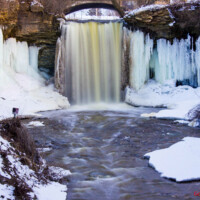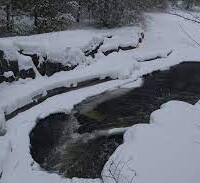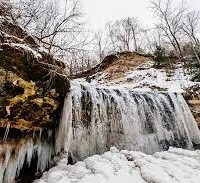
I listened with interest earlier this month about President Biden’s renewable energy goals. Offshore wind farms are cropping up on the US coasts, but I couldn’t help but wonder “what about the Great Lakes? America’s Freshwater Coast?”
Biden plans to increase funding for alternative energy programs to reach net-zero energy emissions by 2050. This includes a goal of producing 30 gigawatts of offshore wind energy by 2030.
The most completed US offshore wind project to date is the Block Island Wind Farm off the coast of Rhode Island. It has five turbines, each capable of supplying six megawatts of power (enough for about 17,000 homes). Dozens more projects are in progress, including much larger wind farms off the coasts of New York, Pennsylvania, Virginia, and California. And, just this week there was news of the first lease sale of offshore wind energy in the Gulf Shore.
This offshore global map showcases just how many fully commissioned projects there are. It also includes those under construction, and where potential has been mapped out.
Why Offshore Wind Farms?
According to nationalgrid.com, offshore wind production is “considered more efficient than onshore wind farms, thanks to the higher speed of winds, greater consistency and lack of physical interference that the land or human-made objects can present.” Offshore energy production is also thought to have a smaller environmental impact and makes use of the vast, open space of the sea.
The Office of Energy Efficiency & Renewable Energy also notes that offshore turbines can be larger – potentially 820 feet in circumference vs an onshore maximum of 400 feet. This increase in size also means an increase in energy production and efficiency.
Floating Wind Turbines
Most current offshore turbines are anchored to the sea floor. New technologies in floating turbines, however, are changing the potential for clean energy production. Non-floating turbines cannot be established in seawater deeper than 60 meters. And they’re smaller.
Further from shore, where winds are more stable and stronger, floating turbines present a real economic and feasibility advantage. They’re easier to manufacture and install, there’s less visual impact, and the capacity for capturing wind resources is huge.
The US Department of Energy has established a program called the “Floating Offshore Wind Shot” which – similar to the “Earthshot” program – is aimed at promoting ingenuity “to tackle key remaining technical challenges to reaching US climate goals.” The initiative includes more than clean energy production, but also plans to revitalize port communities, and create jobs in operations, construction, and maintenance.
(PS if your wondering how floating wind turbines work, how they can just float out in the wild ocean (or Great Lake) without being attached to the sea floor, see the video below – it’s pretty fascinating.)
What Does this Mean for the Great Lakes?
 Maps showing the wind resource potential in the US include the Great Lakes, not just the oceanic coasts. There’s plenty of consistent wind out there and with so many dense population areas along the coastline, offshore is an ideal candidate for streamlined energy production and distribution.
Maps showing the wind resource potential in the US include the Great Lakes, not just the oceanic coasts. There’s plenty of consistent wind out there and with so many dense population areas along the coastline, offshore is an ideal candidate for streamlined energy production and distribution.
Until recently, the available technology stymied the establishment of offshore wind farms in the Great Lakes. For one, the 60-meter depth limit for fixed-bottom turbines meant that the turbines would be visible from land, a criticism from many shoreline communities.
Secondly, the fact that many of the Great Lakes ice over in the winter meant that traditionally-built structures would not suffice.
Enter the “Icebreaker,” the first freshwater wind farm in the US. Lake Erie’s new project uses a play on words that’s meant to indicate that the turbines are designed to withstand ice formation (not needed in saltwater locations), and that it’s a pilot program that showcases what can be done in the Great Lakes region. It has not progressed without controversy and legal battles but so far, it looks like the project will proceed.
Does Wind Energy Impact Nature?
- Some of the arguments against wind energy, including offshore production, include the impact to wildlife such as birds and bats. While more research and solutions may be needed, the Audubon Society has publicly stated that climate change is a greater risk to birds than are wind turbines.
- Additionally, the news has recently featured numerous accounts of whales washing up on America’s east coast. While some cite the recent offshore wind projects as a cause for the whales’ deaths, others refute these claims as misinformation.
Find Out More About Wind Energy
- The Great Lakes Offshore Wind Energy Consortium exists to “enhance coordination among participating federal and Great Lakes state regulatory agencies” to tap into and facilitate the use of wind energy in the region. Learn about their work, and which states have joined the consortium (and which have not…uhem, Wisconsin).
- The National Renewable Energy Laboratory (NREL) – which aims to transform “energy through research, development, commercialization, and deployment of renewable energy and energy efficiency technologies” – posted this 2020 webinar all about floating turbines. It’s an hour long but of interest are:
- 12:00 depiction of the difference between fixed-bottom and floating turbines
- 14:40 map of where coastal wind resources match where people live
- 18:16 map of potential wind resources – which are 2 times greater than US electric energy use, btw
- 22:00 relating to Great Lakes technology and ice-breaking
- Bloomberg Originals offers this excellent dive into the issues and innovations surrounding floating offshore wind – take a look (~17mins):
What To Do Before Winter Ends
Nature Net’s newest Intern, Charlotte, took a visit to a winter waterfall. She thinks you should do the same! And she’s done all the homework for you. Find out where to go and what to know for your next frozen adventure…








In Case You Missed It…
News from Nature Net Members
| Bethel Horizons is continuing their “Cooking with Chef Cena” series this spring with opportunities to learn Indian and Italian food preparation (in March and April, respectively). Learn cooking techniques, share a meal, and take the recipes home. Also, the last “Breakfast with the Birds” of the season will take place in March. Sign up today. | The UW-Madison Arboretum is once again offering their Spring Volunteer training as well as their Restoration Team Leader training! These opportunities vary in duties from recording trail conditions to improving natural habitats for wildlife and endangered species. There are several training dates offered, with the first one being March 29. | The last known male Siberian Crane in the species’ western population, Omid, now has a potential mate. A female Siberian Crane who was raised in a breeding center has been introduced to Omid’s winter habitat in Iran. The International Crane Foundation staff is hopeful for the pair’s bonding and breeding success. Find out more here. |
More from Nature Net…
| For Families: | For Educators: | Upcoming Events: |
 |
 |
 |
| In honor of the rare Green comet passing through, take a look at our Favorite Constellation Books to explore space through reading! | Check out our updated Wildlife Wednesday archive for fun facts to share in class or with fellow educators! | While you’re anxiously waiting for Maple Sugar Fest season, check out our other upcoming events to keep things fun during the winter! |





